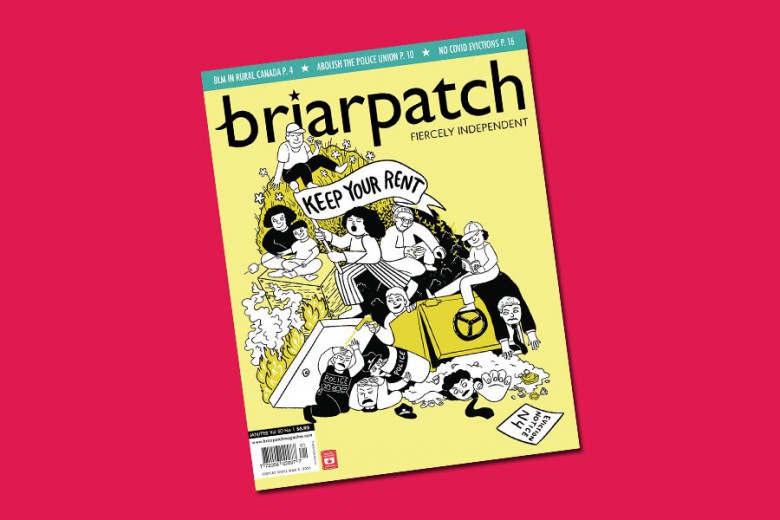The Union Pearson Express rail link, operated by Metrolinx, will get you from Toronto Pearson Airport to downtown Toronto in 25 minutes. It was a vast improvement over the pre-existing buses, which – after navigating Toronto traffic and construction – would often take over an hour. And when it was first opened in 2015, you would also pay for the privilege: it cost an adult rider without a PRESTO card $27.50 one way. There were discounts available for airport workers, but a monthly pass was still $300 per month, and a one-way ticket was $10.
This was unacceptable to the Toronto Airport Workers’ Council (TAWC), a non-union organization that represents Pearson’s workers. It was also unacceptable to their community partners, groups like TTCriders and the Clean Train Coalition.
“We were gonna start picketing the train,” says Sean Smith, a Unifor member and TAWC activist. “And if need be we were going to block the route.”
“One of the main things that got me involved in [the TAWC] was the proposed train, the UP Express, because that meant it was another way to get to work,” says Tracy Rowan. She is a flight attendant, Canadian Union of Public Employees (CUPE) member, and TAWC activist. “We got the fare changed because we crashed [Metrolinx’s] meeting. That’s some of the most fun I’ve ever had as a group, crashing a board meeting, and seeing things change because of what we did.”
“We were gonna start picketing the train,” says Sean Smith, a Unifor member and TAWC activist. “And if need be we were going to block the route.”
Today, thanks in part to the TAWC’s militant activism, it costs $12.35 for an adult rider to take the UP Express without a PRESTO card, but $3.50 for any airport worker.
For Smith, the campaign’s success was proof that the TAWC’s model of forming links between community groups and trade unions within the workplace was an effective way to fight the erosion of public services that occurs under neoliberal governments.
“When we, as workers, just fight as workers, we are suppressed either through aggressive employer tactics or through the state, or a combination of both,” says Smith. “We see the linkage between public service workers and airport workers in that we’re on the front lines of neoliberalism. The engagement with the community comes from the realization that they too are on the front lines of neoliberalism.”
“Wall-to-wall airport organized”
Toronto Pearson Airport is Canada’s largest workplace, with over 50,000 workers. Among them are the small but noteworthy group of workers who formed the TAWC in 2012, an organization open to all Pearson workers – “from customs officers to duty-free workers to security officers to flight attendants,” says Smith.
“It’s pretty much wall-to-wall airport organized now,” he explains. “The critical thing about it is we’re all workers. We all work at the airport.”
There are six unions involved in the solidarity pact that formed the TAWC: CUPE, the International Association of Machinists and Aerospace Workers (IAMAW), the Public Service Alliance of Canada Customs and Immigration Union (PSAC-CIU), the Service Employees International Union (SEIU), Teamsters Local 419, and Unifor. Though the TAWC is a completely volunteer-led organization, the bulk of dedicated TAWC activists are local-level officers within these unions, and Smith makes it clear that he does not consider the TAWC to be a form of dual unionism.
“Often calls for labour movement renewal talk about alternative forms of workers’ associations or workers’ organizations,” said Paul Christopher Gray, assistant professor of labour studies at Brock University. He and his co-researcher, Jordan House, have also been involved in public education efforts and airport worker solidarity actions through the Toronto Labour Committee. “What we thought was quite interesting about the TAWC was that it is a workers’ organization. It is not a union, and yet unlike a lot of the other proposed alternative forms of workers’ associations, it is based in a workplace, at the site of production. It engages in direct actions, things that can be disruptive at the point of production that often the alternative forms of labour organizing can’t be.”
“It is not a union, and yet unlike a lot of the other proposed alternative forms of workers’ associations, it is based in a workplace, at the site of production.”
Forms of labour organizing that are not workplace-based, like solidarity committees and workers’ councils, can rely heavily on tactics like protests and lobbying that, while putting pressure on an employer, do not directly confront them. But there is no substitution for action taken in the workplace to disrupt production. As a model, the TAWC serves as a middle ground between these alternative workers’ associations and traditional trade unions.
The TAWC’s growth has been slow but steady. Apart from their main tactic of one-on-one conversations with workers, the TAWC has been working on becoming more visible in the airport: they have an agreement with the Greater Toronto Airports Authority (GTAA) that allows them to table in the walkways going to and from employee parking. They hand out leaflets at transit hubs and put up posters in lunchrooms. And they take advantage of pre-existing union infrastructure like newsletters and local meetings to communicate with workers.
Smith believes that it’s crucial to see the workplace as a community. This is what allows workers at Pearson to reach across collective bargaining agreements and compartmentalized struggles to form a common front.
“Everywhere you look, there’s workers from 249 other companies going through the same issue. You have to start looking at things from a broader community perspective. If your house and every other house in your neighbourhood is on fire, you have a community issue, not just a house issue,” he emphasizes.
“A much stronger, more powerful tool”
Over a nine-month period in 2011 and 2012, Air Canada workers dealt with four instances of back-to-work legislation being threatened, introduced, or passed. This legislation could make strikes illegal, punishing rank-and-file workers with fines or even jail time for defying the law and staying out on strike. Workplace actions at Pearson need to be big and fast, in order to have an impact on employers before the government has a chance to deploy back-to-work legislation.
“When one group of workers goes on strike, if they are part of the six solidarity pact unions, we all engage in solidarity actions on their behalf,” says Smith. This can include tactics from work to rule, where workers perform only the minimum amount of work required by their contract, to solidarity rallies and phone zaps, where workers will tie up phone lines by repeatedly calling head offices en masse. “So, the strike becomes a much stronger, more powerful tool.”
“When one group of workers goes on strike, if they are part of the six solidarity pact unions, we all engage in solidarity actions on their behalf.”
In Canada, labour law in the postwar period tended to favour the formation of craft unions – bargaining units formed based on the activities done at work, rather than the workplace or sector itself. This has historically weakened the labour movement – since it allowed for multiple unions to exist in one workplace, they competed with one another for members and made it much more difficult to engage in collective activity. Labor Notes co-founder Kim Moody, however, believes this organization of work presents a strategic opening.
“You could have a general strike of everybody in an airport, and obviously that would be devastating to air transport. But you could also think about what groups of workers have a particularly powerful position. Whose actions, even if it’s just a work to rule, could impact not only their particular jobs, but the airport as a whole?” notes Moody. “Where in logistics is there a vulnerable point? The answer is that they’re all over the place. You just have to figure out which are the most important ones.”
The racialization of the workforce
Contract flipping is a major issue for workers at Pearson. Because airports in Canada are privately operated, services are often subcontracted out to employers. When a different employer wins a contract, airport workers must reapply for their jobs, often losing negotiated benefits, seniority, and salary increases.
“With contract flipping, you often have groups of workers who aren’t sure what their union will be in a few years because their work will be contracted out, the contract will be flipped. They may find themselves in the same union, a different union, no union at all,” says Gray. “Many of the workers in Canadian airports are considered federal workers and there are gaps in the labour laws for federal workers.”
One of these gaps is successorship rights, which are common in both the private and public sector but rarely apply to federal workers. With successorship rights, if the conditions of the job change – for example, if a new service provider is awarded the contract – but the type of work remains the same, the new employer is required to maintain union-negotiated work standards. Without successorship rights, negotiated wages and seniority can be lost when there’s a new employer.
“With contract flipping, you often have groups of workers who aren’t sure what their union will be in a few years because their work will be contracted out, the contract will be flipped.”
Contract flipping makes it difficult for trade unions to build a base of activists and organizers on the shop floor, and it also suppresses wages across the airport. TAWC activist Yavar Qadri believes contract flipping is a deliberate strategy to make it more difficult for workers to organize.
“We depend on these contracts to just exist. It’s a dehumanizing experience, but it’s just how it is. It’s very hard to convince people to come to a rally. It’s very hard to convince people to strike,” he says. “People are afraid. It’s the fear. It’s the learned helplessness.”
A high proportion of the workers that experience contract flipping at Pearson are immigrant workers and workers of colour, living in the nearby suburbs of Brampton, Mississauga, and Etobicoke. Smith explains that workers who are employed in the public sector or by the airport authority tend to have better working conditions, benefits, and job security than contract workers – but contract workers are more likely to be people of colour.
“What we’re seeing is date of hire. As the airport and companies privatize, and neoliberalism kick[s] in, every subsequent generation has worse working conditions, which then drives down the wages of the economy and the surrounding community,” Smith says. “And what we’re seeing is that the surrounding communities of the airport are pockets of poverty, and that’s where racialized workers are living.”
The introduction of precarious work has gone hand in hand with both the racialization of the workforce and the boom of mass tourism.
“There’s been this conversion of air travel into a mass tourism industry. And one of the ways this has been accomplished is greatly deteriorating working conditions and lowering the compensation and benefits that workers receive,” says Gray.
Qadri says that it is immigrants who must accept the most dangerous and precarious work at Pearson.
“Most of the people who work here in the airport in low-paying jobs are first-generation immigrants. It’s about not being born and raised here in Canada,” he says. “These things are being taken advantage of by the capitalists here at the airport.”
“There’s been this conversion of air travel into a mass tourism industry. And one of the ways this has been accomplished is greatly deteriorating working conditions and lowering the compensation and benefits that workers receive.”
For Smith, pressuring the federal government to create reports and legislation that impact the workers affected by contract flipping is a way of organizing some of the most unprotected workers at Pearson. Now, an employee’s length of service is treated as continuous under new contract flipping protections passed by the federal government in 2018.
“We’re tackling it on demographic issues, on community issues, and from the most vulnerable,” he said. “Racialized workers are the most vulnerable, and by raising their living standards, you raise [them] for everyone else.”
Challenging the labour orthodoxy
But this growth is not without growing pains. Trade unions remain skeptical of dual unionism – the development of a parallel structure within or analogous to a pre-existing trade union – and TAWC activists remain firm that the workers’ council is complementary to pre-existing union structures.
“This is not dual unionism. We’re all proud of our respective unions; we all work within our respective unions,” says Smith. “But when it comes to issues that involve multiple groups of employers, multiple unions, collective community issues, this is where the community union model comes in. It fills the gap that collective bargaining can’t; it does not replace collective bargaining.”
The TAWC has also managed to operate relatively free from national-level conflicts among Canadian trade unions. In January of 2018, one of the six solidarity pact unions, Unifor, disaffiliated from the Canadian Labour Congress after it allegedly began raiding other unions’ workplaces. Neither Smith, who is a Unifor member, nor Rowan, who is a member of CUPE, felt that Unifor’s disaffiliation impacted their ability to do work with the TAWC.
“It fills the gap that collective bargaining can’t; it does not replace collective bargaining.”
“Actually, it’s kind of a unique thing and you don’t really figure it out until you’ve been at a few meetings or gone to an event. We’re all figuring it out together, but we’re independent of the politics going on in Ottawa or in union headquarters,” explains Rowan. “I get along great with Unifor workers even though Unifor disassociated from a governing labour body. It’s important for me to get along with Unifor members at the airport. We are very democratic. We all share ideas and each other’s injuries and victories and losses.”
In fact, “A lot of these workers walk back into their own unions from the TAWC and start to ask difficult questions of the labour movement,” says Gray.
“Workers within the TAWC are engaging in some exciting conversations and exciting activities. They are collaborating with other airport workers who aren’t in their own union in a way that they weren’t doing before through their union. They are engaging in strategic discussions through the workers’ council in a way that they often were not in their own unions. They are engaging in direct action in a way that they often were not in their own unions,” he continues. “This can’t help but challenge some of what the airport unions are currently doing and what the broader labour movement is currently doing.”
The questions that TAWC workers are asking of their unions will be questions worth seriously examining – the TAWC is a relatively small group, but they are expanding steadily and have won real gains for Pearson workers, from a $3.50 fare on the UP Express to a working relationship with the GTAA that supersedes their individual employers. Now, when the airport authority designs its check-in counters, it meets with representatives from the TAWC to ensure that workers are involved in the process.
“These things that you learn in the union movement, when they work, they are used by everyone in the union movement,” says Qadri. “I see the TAWC growing. I don’t know how fast that’s gonna be, but it’s going to grow to be very powerful, as big as the airport is, as powerful as the airport is.”







